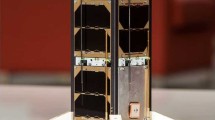Abstract
The bandwidth demand in radio communications is increasing every year, not only in the terrestrial domain, but also in the satellite domain. The Ku Band is already at its capacity limit and the higher Ka Band is filling rapidly and will reach its capacity limit in the years to come. From both the research and commercial point of view it is important to explore the next frontier for satellite communication, which is the Q/V band. In radio communication it is not only a simple up-scaling of the frequency to achieve the same gain with smaller antennas as with bigger antennas in lower bands, but it is the challenge to handle the different wave propagation properties of these higher bands. In Q/V band the atmospheric attenuations are changing quicker than in lower bands (up to 3 dB/s) and the scintillation caused by gas density changes are in the region of 1 Hz with amplitudes of up to 2 dB.
The newly developed ground station in Graz will now help to answer basic research questions in the exploration of the Q/V band. The questions are for instance: Which fade mitigation technique is the best to operate a modem via the Q/V band channel or which averaging times shall be used to have the highest availability with the lowest required margins. Joanneum Research will investigate the optimal operation of this channel together with researchers from the University of Rome Tor Vergata and in the wave propagation domain together with the Politecnico di Milano.
The first part of the paper describes the ground station design for the communication experiments to be operated over the Q/V band communication transponder of Alphasat, called Aldo Paraboni payload.
In addition to the Q/V band Ground Station, in the frame of ESA’s ARTES-5 programme, a beacon receiver was designed and manufactured, for measurement of the Ka/Q band beacon signals provided by the Alphasat Technological Demonstration Payload 5 as well. This receiver measures co-polar and cross-polar signal at Ka and Q band with one antenna feed and provides a perfect measure of the actual signal quality.
Zusammenfassung
Die Nachfrage nach mehr Bandbreite in der Radiokommunikation steigt jedes Jahr – nicht nur in der terrestrischen Kommunikation, sondern auch in der Satellitenkommunikation. Daher stößt die Kapazität des Ku-Bandes derzeit an ihre Grenzen, und auch das höhere Ka-Band füllt sich schnell und wird somit in den kommenden Jahren seine Kapazitätsgrenze erreichen. Aus wissenschaftlicher und längerfristig auch aus kommerzieller Sicht ist es deshalb sehr wichtig, das nächste Neuland der Satellitenkommunikation, nämlich das Q/V-Band, zu erforschen. In der Radiokommunikation geht es nicht nur um die simple Hochskalierung der Frequenz zum Erreichen des gleichen Verstärkungsgrades mit kleineren Antennen wie mit größeren Antennen in niedrigeren Bändern. Eine Herausforderung ist es vor allem, die verschiedenen Eigenschaften der Wellenausbreitung in diesen höheren Frequenzbändern handzuhaben. Atmosphärische Dämpfungen ändern sich im Q/V-Band schneller als in niedrigeren Frequenzbändern (bis zu 3 dB/s), und Signalschwankungen, verursacht durch sich ändernde Gasdichte, treten im Bereich von 1 Hz mit Amplituden von bis zu 2 dB auf.
Die neu entwickelte Bodenstation in Graz wird nun helfen, grundlegende Fragen in der Erforschung des Q/V-Bandes zu beantworten. Diese Fragen sind zum Beispiel: Welche Technik zum Ausgleich der Signalschwankungen eignet sich am besten, um ein Modem über den Q/V-Bandkanal zu betreiben? Welche zeitliche Mittelung soll verwendet werden, um die höchste Verfügbarkeit mit den niedrigsten notwendigen Reserven sicherzustellen? Der erste Teil des Artikels beschreibt den Aufbau der Bodenstation für Kommunikationsexperimente.
Zusätzlich zur Q/V-Band-Bodenstation wurde im Rahmen des ARTES-5-Programms der ESA ein Beacon-Empfänger entwickelt und implementiert, um Messungen des Beacon-Signals vom Ka/Q-Band aus dem „Alphasat Technological Demonstration Payload 5“ durchzuführen. Dieser Empfänger misst co-polare und cross-polare Signale am Ka- und Q-Band mit einem Antennenfeed und stellt somit eine perfekte Messung der aktuellen Signalqualität dar.






Similar content being viewed by others
References
Standard Number: EIA EIA-411-A-1986 (1986): Electrical and mechanical characteristics of earth station antennas for satellite communications. 1986-9-1. Electronic Industries Alliance (EIA).
Schwerdtfeger, R. (2010): Microwave reflector antenna design: concepts and techniques.
Acknowledgements
The project to design, build and operate the Q/V ground station in Graz/Austria was funded under ESA contract 4000102639/10/NL/CLP. The Alphasat Ground Propagation Terminal has been developed under ESA contract 22354/09/NL/LvH. The team likes to thank the Austrian ESA delegation for supporting these projects and the ESA technical officers Mr Juan Rivera Castro and Mr Antonio Martelluci for their guidance and expertise in this complex project.
Author information
Authors and Affiliations
Corresponding author
Rights and permissions
About this article
Cite this article
Schmidt, M., Schönhuber, M., Ebert, J. et al. Austrian satellite ground station for the Alphasat Q/V band experiments. Elektrotech. Inftech. 131, 150–154 (2014). https://doi.org/10.1007/s00502-014-0220-2
Received:
Accepted:
Published:
Issue Date:
DOI: https://doi.org/10.1007/s00502-014-0220-2




